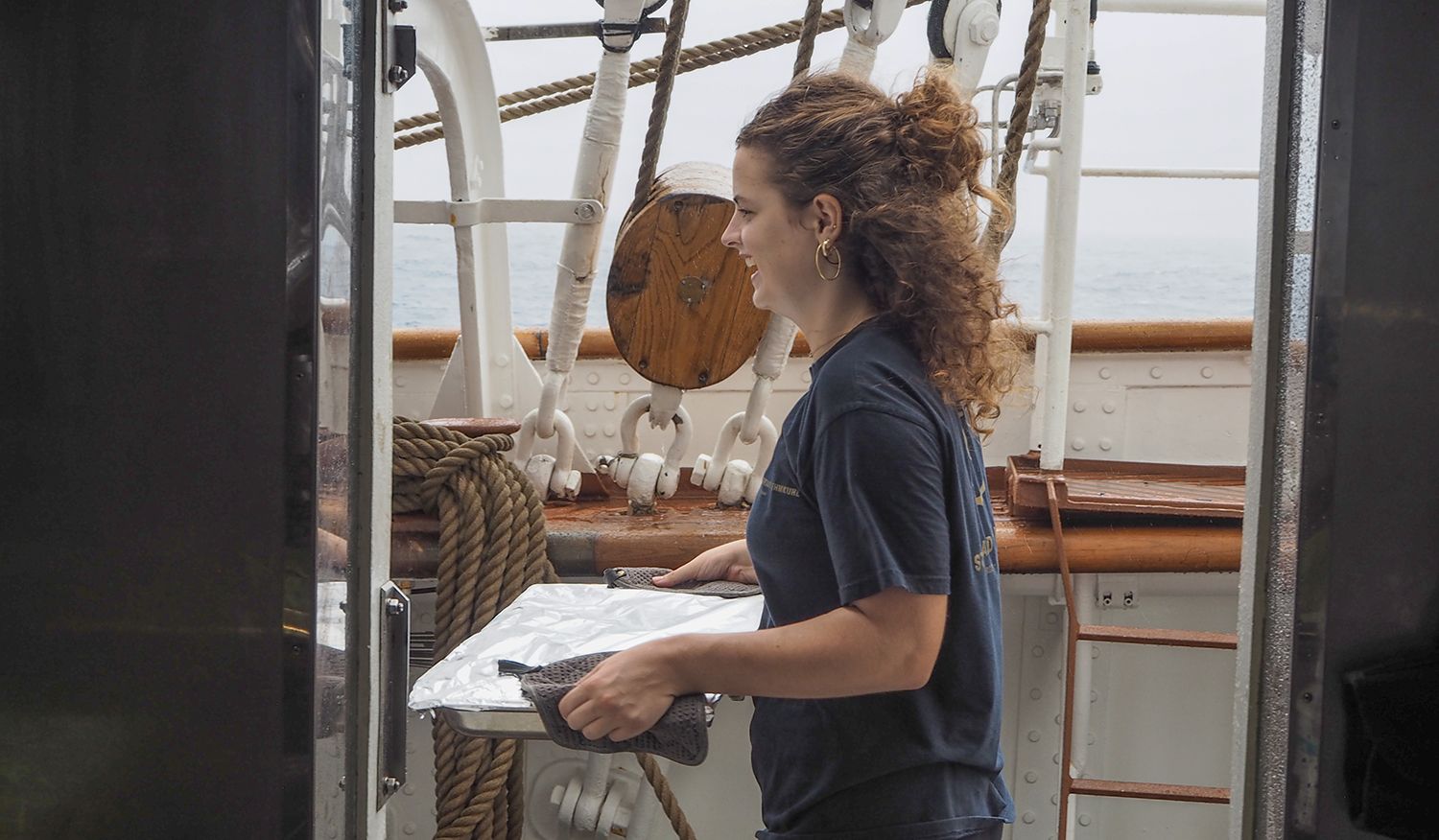Nothing that can be eaten is thrown away in the galley on board Statsraad Lehmkuhl.
This article was published during the One Ocean Expedition 2021-2023.
The dark blue morning sky is reflected in the great roaring sea. Around the ship there is white foam, and it rocks well underfoot when you move around on deck. Outside the galley it still smells of the crisp bacon made for breakfast, and inside is a smiling chef with dark skin and a navy blue uniform.
- Have you ever seen 20 liters of waffle batter before?
Khoa Dang Pham has worked as a cook at Statsraad Lehmkuhl for a total of six years, and now he is the head of the galley, the kitchen on board. In his hands he holds a ladle, and in front of him are three gigantic pails half full of batter, which will become waffles for the whole ship for the 3 o'clock coffee.

Yesterday's dinner is today's lunch
On the other side of the galley stands the apprentices, Kamilla Larsen and Jakob Rødland. Larsen peels potatoes for dinner, and Rødland has just rolled out buns, ready for the oven.
He is now preparing yesterday's lasagne, soon to be served for lunch.
- What sets Lehmkuhl apart from other places is probably that we use the leftovers from yesterday's dinner for lunch today. No other restaurant would do that, says Pham proudly.

Vegetarian food
Pham has also introduced a few more vegetarian dishes on the menu. But even though they are on an expedition with a focus on sustainability, they have kept vegetarian dinners to about once a week. Pham does not believe that everyone would be satisfied with an all-vegetarian menu.
- The first person to complain then would probably be the chief engineer, Jonas Hollænder Jensen, says Pham and laughs.

He picks up the ladle again and continues to fill the pans with waffle batter, while he looks a little nervously out of the door to see if the chief engineer, who is standing outside, heard what he said.
Planning
Pham explains that it would have been difficult to serve only vegetarian food, even if people had wanted to. It requires a lot of food which are difficult to keep fresh when you are out at sea for several weeks.
Statsraad Lehmkuhl received additional supplies in Singapore, 35 pallets of food. In Jakarta, three new pallets came on board - all carried up the gangway and stowed below deck. The food is ordered well in advance, there is no room for local improvisations.

The reason is that all meals are planned before departure, well in advance. The better planned, the less waste. In addition, Pham has an extra trick to use as much of the food as possible.
- We can actually make whatever dishes we want from the food we have on board.
This is a main advantage compared to cooking on land. Here, the chefs can adapt the menu to what is fresh, and use it as they wish. In this way, there will also be greater variety in the dinners each day.

A little more careful
Working as a chef at sea also implies a few other challenges you don't have on land.
Inside the galley, a thin blue anti-slip mat is placed under all loose objects on the bench. The kettles are encircled by a gate around the hobs, and when Pham picks up the knife it goes at a slightly slower pace than it would on land. At sea, you have to chop a little more slowly with the knife.
- There is not that much that is different, really. But some small things are of course done differently, and some may also experience a little extra seasickness when you are inside the galley with many different smells, says Pham.

Buffet
At Lehmkuhl, all meals are served as a buffet. This makes Phams job more pleasant, it is much calmer than having to serve one portion at a time at a restaurant.
- I don't notice a very big difference between whether we have 70 or 170 people on board.
The biggest difference is probably that he has to boil more potatoes, and that the bowl for the waffle batter must be a little bit bigger.
On duty since three
Pham grabs the now completely full pans of waffle batter. He covers them with plastic and puts them in the fridge. Apprentice Larsen appears.
- Now I'm going to bed, she says, behind a small yawn.
It's only 10 o'clock, but Larsen has been on duty since three last night, and will be back on duty at four this afternoon.
- That is probably the only drawback, that the working days at sea are a little longer than at home, points out Pham.
But he still walks around with a constant smile on his face. At sea the pace is more quiet, and when he is not at sea he has long months off.
- I wouldn't want to work anywhere else but here. Working at Lehmkuhl must be the dream job.

Translated into English by Ronald Toppe




